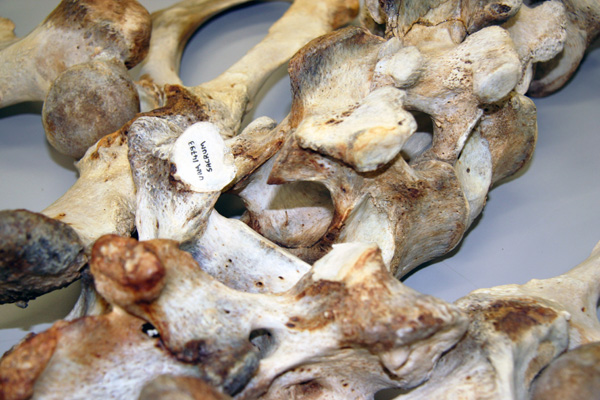Walrus
Pacific walrus population trends study

OCTOBER 2013 - Thousands of specimens housed at the University of Alaska Museum of the North will be used as part of a $1.7 million grant to study long-term and ongoing population trends in the Pacific walrus.
Curator of Mammals Link Olson likens the collection to a "vast library." The books are the specimens themselves—some thousands of years old—collected over the past century by naturalists, archaeologists, biologists and subsistence hunters.
Olson, together with Tara Fulton from the University of Alberta, will use cutting-edge technology in the museum's Ancient DNA Lab to extract minute quantities of DNA from walrus specimens going back two millennia, providing insight into the overall genetic health of the species.
The Ancient DNA Lab, built as part of the museum's expansion, is the only dedicated lab of its kind in the state of Alaska and one of the only ancient DNA labs in a museum in which the polymerase chain reaction (PCR) has never been conducted.

PCR is a chemical reaction that allows scientists to make the millions of copies of DNA needed to determine a sequence of nucleotides, the letters that make up a genetic code. A successful PCR reaction can produce more copies of a targeted gene than originally existed in all the cells of the organism itself. Even under tightly controlled conditions, tens of thousands of errant copies escape into the air and, like microscopic dust motes, find their way into every nook, cranny, and crevice.
Specimens that are very, very old contain low numbers of DNA that are often degraded, but PCR is so sensitive it can find and copy a single remaining piece of genetic code. It’s the powerful magnet that lets researchers locate a needle in a haystack. Conducting PCR inside the same building used to house those specimens, however, is akin to burying the entire haystack under a pile of scrap metal. Worse, once contaminated with PCR products, specimens are all but impossible to decontaminate without destroying their own DNA.
“We are fortunate to have had the foresight to avoid this problem,” says Olson, whose own research has benefitted from having a “clean” facility for working with degraded DNA. Olson credits the curators who agreed to keep the museum PCR free when planning for the expansion prior to his arrival ten years ago.
All the museum curators and their students who study the DNA of their organisms conduct PCR in labs housed in separate buildings at UAF. While walking between buildings at -40» may seem inconvenient, “the alternative—permanently compromising the integrity of over 1.5 million irreplaceable objects and specimens—is unthinkable,” says Olson.
Since the lab’s completion, Olson has been able to leverage several NSF grants to study, among other things, the genetics of Southeast Asian treeshrews, South American primates, and now walruses—all using material tens, hundreds, and now thousands of years old.

The Pacific walrus project brings together scientists from the U.S. and Canada with expertise in genetics, archeology, chemistry, ecology, and ethnohistory to study the marine mammals, whose sea ice habitat has been markedly receding in recent years. Pacific walruses are critical to subsistence in many coastal villages.
Nicole Misarti of the UAF Institute of Northern Engineering and Lara Horstmann-Dehn, an assistant professor in the UAF School of Fisheries and Ocean Sciences, will obtain stable isotope, trace element, and hormone data from the same specimens to look for shifts in feeding ecology and foraging location as well as any associated stress responses. Anne Jensen, an archaeologist and senior scientist at UIC Science LLC in Barrow, will collect additional walrus samples from archaeological repositories and help the team interpret their findings in a broader cultural and historical context, as will the numerous Alaska Native organizations participating in the study.
In addition, a translator will search through hundreds of interviews archived at the UAF Rasmuson Library that contain traditional ecological knowledge of Pacific walruses. Even high school students will have a chance to participate in the project through the Rural Alaska Honors Institute program at UAF and in Barrow.

